Life As A Helicopter Pilot
The Genesis of a Chopper-Jockey
ARTICLE DATE: September/October 1986
There was a time in my not-so-distant but oh-so-shameful past when the art and craft of helicopter flight held something of a magical aura. I was mildly amazed at the scores of chopper jockeys who would go hovering by my meager fixed wing seemingly repudiating everything that Newton had discussed years ago after losing a fight with an apple tree.
Akin to magic, flying a helicopter was a skill that I very much wanted to learn and master — despite the outrageous training costs in vogue at the time. As such, I silently vowed that the day would come when I would be able to look at my pilot’s license and note the addition of an endorsement for rotocraft-helicopter.
Not so long ago, an enterprising engineer by the name of Frank Robinson gave some serious thought to the development of a cost effective, economical, high performance light helicopter. So serious was his thinking that he actually accomplished the research, construction and certification of such a machine — known today as the Robinson R-22.
The R-22 was faster, more economical and far more responsive than most piston helicopters so it didn’t take long for it to become the number one bestseller among its brethren (much to the collective consternation of the rest of those in the piston helicopter Biz).
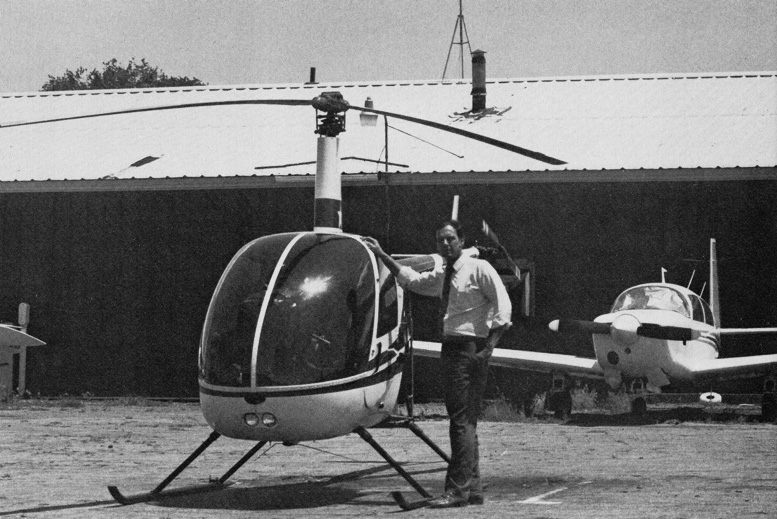
Larry Durocher, President of Northwest Helicopters had nothing else to do, so he posed for this picture. Larry also serves as the FAA designated helicopter examiner for his area.
Most importantly, this machine singlehandedly cut the costs of flight training to a level that was approximately half that of what students had been forced to pay in the past.
As a result, student training started increasing and a host of R-22 training schools popped up all across the country and around the world to undertake the training of thousands of would-be rotor-jockeys.
Even more interesting is the fact that in a few exceptionally well qualified Part 141 certificated schools, it is now possible for an appropriately rated pilot to earn a private license in 25 hours or a Commercial license in as little as 30 hours as an “add-on” rating to existing certificates.
This was all I needed to know in order to finally make a beeline for the bank and add a rotorcraft rating to my tickets. I pursued my own uplifting ambitions at NorthEast Helicopter’s Ellington, Connecticut, training facility (just a stone’s throw from the teeming metropolis of Hartford).
NHI utilizes the R-22 for most of their training operations and offers the Bell 47, and Bell 206 for advanced training and charter. NHI’s flight instructors are all graduates of the approved Robinson Instructor Safety Course as well as being former students of NHI.
Several full time instructors and nearly a dozen helicopters offer much more than ample opportunity for training as well as an on staff FAA Examiner (NHI President Larry Durocher). Most attractive about NHI’s flight school was the very reasonable rates for rental and flight instruction.
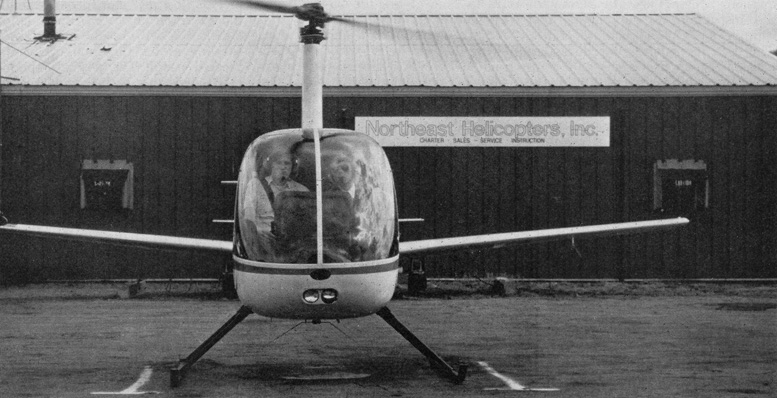
Trick photography! The semi-hidden Mooney in this background makes this R-22 look as if it has sprouted wings . . .
Additionally, NHI is one of the few flight schools that are qualified to award the commercial helicopter add-on in as little as 30 hours. This is quite a distinction.
Close inspection of their facilities reveals a very maintenance conscious service facility located within the same building as the flight school, good training practices, friendly staff members and a full-time coffeepot — sounded good to me.
With all of these reassuring details firmly ensconced in my noggin’, I decided to throw caution to the wind (along with a healthy portion of my bank account) and signed up for their hover lovin’ 30 hour Commercial license add-on rating course. I did look forward to the start of my training.
I had done a lot of reading about helicopters (this made me a qualified “Armchair” Expert) but my previous experience in rotor-craft was pretty much confined to a radio-controlled model that had as many crashes logged as it did take-offs.
I was hoping (in vain, I might add) that several thousand hours of fixed wing time would help me in my pursuit of the elusive rotorcraft rating but I wasn’t sure if that was trying to mix apples with hand grenades. Only time would tell.
My instructor/tour guide/lifeguard for this sordid misadventure turned out to be a very mellow fellow who had amassed (and lived through) over a thousand hours in the R-22; first as one of NHI’s students and then as one of their flight instructors.
Paul Koutruba spent the first hour of our association teaching me the survival intensive rudiments of a proper rotorcraft pre-flight. It became painfully obvious in the first few moments that any chopper pre-flight had to be a rather involved undertaking.
The mechanical complexity of helicopters demands far more than a simple “kick the tires and light the fires” type of inspection that has unfortunately become so much the rage among the fixed wing population. Robinson’s R-22 is actually a fairly simple machine, as helicopters go, but the walk around is still a lengthy affair that covers a lot of ground.
The R-22 uses a derated Lycoming for its motive force which is mounted to the rear and slightly below the cockpit that would be my classroom for at least the next 30 hours (give or take a few years . . .).
The inspection process starts on the right side of this aluminum bumble bee in a cowling just above the engine. The cowling offers access to the main and tail rotor drive shafts as well as various control rods and systems. Walking back along the tail boom leads to the tail rotor and its transmission.
Moving forward allows for the inspection of the engine, fuel supply, and main rotor assembly. This is a meticulous procedure that became a great deal easier as I gained some familiarity with all the equipment and its appropriate nomenclature.
This aircraft had obviously been designed with the ease of pre-flight in mind and I found it only moderately challenging to perform a proper pre-flight. The start-up procedure is a bit less involved but no less interesting. One of the first shocks upon entering the cabin of the R-22 is the amount of visibility afforded to its occupants.
I felt like a prize goldfish. The fit was snug since winter coats (we’re talking winter in Connecticut . . . Brrr!) tend to be bulkier than summer civvies but it didn’t feel as bad as that encountered in a Cessna 150 (one of the most intimate of flight instruction environments . . .).
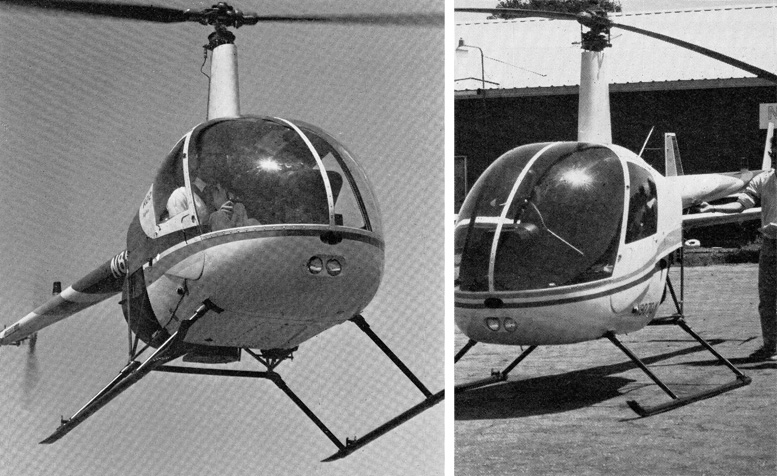
LEFT: Larry Durocher put in thousands of hours of helicopter time in the military before he started NHI several years back. Here, he buzzes the camera.
RIGHT: The R-22 has become the runaway best seller among piston helicopters – outselling all others combined.
The start-up was at least slightly familiar as I checked mixture, mags and master prior to waking the Lycoming from its cold weather snooze. A big departure from the fixed wing world came with making sure that the rotor clutch was disengaged before hitting the starter.
Settling into an idle speed of 55 to 60 percent prepared me for engaging the clutch. In no time at all, the 25-foot rotor bit hold of the power of the Lycoming and started a slow and laborious swing that quickened with every second to become a transparent phantom of the shimmering sky.
The clutch light went out when the rotor speed matched the appropriate engine rpm while I proceeded on to a good old-fashioned mag check (that, at least, I knew how to do—thank God for small favors!).
I got to learn a few new tricks as well while checking the low rotor rpm warning horn (something distantly related to a stall horn) and the sprag clutch (responsible for disengaging the main rotor from the engine in the event that the Lycoming took a hike).
Each R-22 is equipped with carburetor air temperature gauge that helps the pilot to adjust the carburetor heat to guard against the loss of engine power from carburetor ice. Once this and a few other small chores were completed, Paul lifted the R-22 off the ramp and hover taxied to the nearby practice area on the other side of the runway.
The liftoff was fascinating. Some mysterious unseen force (black magic, no doubt) sucked the ground out from underneath us and replaced it with pure unadulterated space (the final frontier . . .). Paul maneuvered us over to the practice area with small, deft, nearly imperceptible movements of the T-Bar cyclic control stick.
My feeling of semi-ethereal bliss was brutally interrupted with the most ominous pronouncement that I’ve heard since my days in the military — “YOU HAVE IT.”. . . What occurred from that point on must have provided endless amusement to a nearby group of observers (hey guys! Come watch this, Campbell’s gonna try and fly it now!).
I hope that they got cramps from their laughter. . . . My first feeble efforts to play pilot-in-command looked more like the faltering, swaying progress of an intoxicated sailor than they did controlled flight (fright?).
Slowly, Paul explained the proper use of each individual control function by giving me control of one function at a time until I showed the proper attitude (literally) to add another function to my limited repertoire.
Soon, I began to handle whole combinations of these functions until I “mastered” the ability to keep the R-22 on the same airport that we started with (Heck, I was doing great!). A helicopter is primarily control- led by a combination of cyclic and collective pitch inputs.
The cyclic controls the helicopter’s progress fore, aft, and side to side. A pair of suspicious looking foot pedals handle inputs to the tail rotor. Stomping on either one will result in the nose skewing in the direction of the depressed pedal.
The normal function of the tail rotor is to counteract the torque produced by the main rotor. The pitch of the main rotor (and its subsequent lift) is controlled by a stick mounted to the left of each pilot’s seat.
This lever bears an uncanny resemblance to the much abused emergency brake on my old Buick and possesses a twist grip throttle. Under normal circumstances, raising the collective pitch lever also increases the engine rpm.
The two are correlated via a mechanical linkage in order to maintain the proper relationship between engine rpm and rotor rpm. This correlated arrangement handles much like a turbine chopper and minor discrepancies between the engine and rotor rpm are adjusted through the twist grip throttle.
One major adjustment that throttle. One major adjustment that I had to make was in learning to use the throttle since it must be twisted opposite the direction I was used to from my motorcycle days.
At any rate, raising and lowering the helicopter collective controls the lift produced by the main rotor and is the means by which a pilot controls his altitude (and thereby his/her destiny).
Flying this creature is a bit like balancing a marble on top of a beach ball. It was getting pretty obvious to me that this was a skill that was going to take a bit of time to master (if, indeed, I ever did — I was beginning to wonder . . .).
The first R22 pilot maneuver taught is the hover
Hovering is one of those exercises that looks fairly simple on the ground but seems impossible to perform once you try it. It took a while to get the hang of hovering but once I had the rough idea, Paul allowed me to try my hand at a few other maneuvers.
Before the first hour had finally come to its conclusion, I had tried liftoffs, hover-taxiing, and an autorotation or two. Autorotations were fun; not at all the blood-chilling terror that I had thought that they would be.
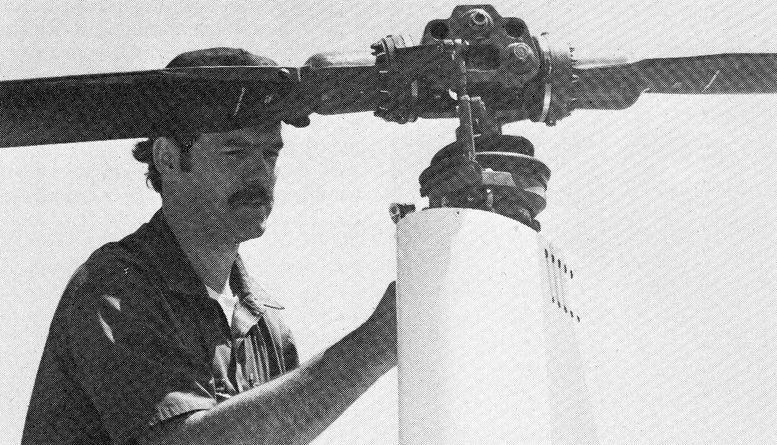
Maintenance manager Rob Brigham gives the rotor head a once over as part of NHI’s very aggressive preventative maintenance program.
Just seeing Paul execute a few effortless (or so it seemed) autorotations with the throttle fully closed took quite a bit of the edge off of my training jitters. Engine failures seemed to pose no more a threat than those in a fixed wing aircraft — as long as one kept their Collective (pun intended) wits about them.
Each type of emergency (rotor or fixed wing) requires prompt effective action from the pilot in command but are readily survivable if you handle the situation properly. The autorotation is probably the most important lesson to learn from the entire course of instruction. Just about every skill that you learn during this course is wrapped up into this one maneuver.
Most important is the immediate commitment to the autorotation sequence. Delays can land you in a world of hurt. The rotor rpm is the first concern since it can decay rapidly if the collective is not lowered rapidly following the power cut.
The next move in this sequence caused the most problem for me. Just after lowering the collective, the pilot in command will usually have to ease back on the cyclic to help “load” the rotor, level the skids and assume a proper attitude for the descent.
My fixed wing reactions wanted me to dump the nose to ensure proper airspeed—this can be a real no-no (not to mention highly exciting). Pushing forward on the cyclic can result in two separate problems.
The first is the additional decay of the rotor rpm since this will “unload” the rotor. The second problem is the fact that the nose is going to want to head for the deck after the power cut anyway and the additional forward input will give one a breathtaking view of the real estate below (guess how I found this out!).
Once firmly established in the autorotation, the landing procedure calls for the selection of a landing sight well within the 4.5 to 1 glide ratio of the R-22 helicopter.
At 40 to 50 feet, an initial flare is started by hauling the cyclic back to slow the forward speed followed closely by the increased use of up collective to arrest the rate of descent before leveling out and contacting the ground.
Most practice “autos” are done with the addition of power just prior to landing to lessen the possibility of an accident. Full touchdown autorotations were eventually taught at NHI but only by the Chief Flight Instructor. There are a lot of maneuvers involved in the process of learning to fly a helicopter.
I think that I was taught all of them prior to my solo flight. I learned “quick stops,” slope landings, running takeoffs and landings, max performance takeoffs and a whole bag full of other chopper tricks. The most impressive group was part of a series called the Robinson Pilot Safety Check.
As a matter of fact, I was required to participate in this series before NHI would even consider soloing me. The RHC Safety Check consists of running through a group of scenarios conducive to pilot error and are in fact a representation of the way that most pilots have come to grief in helicopters.
The R22 pilot Safety check stresses recognition, reaction and resolution of the situation in a safe and proper manner. This program was started as an attempt to increase the safety record of this machine. By all reports, it is a resounding success.
On a frigid Saturday in early 1984, Paul Koutruba committed a serious error in judgment and allowed me to solo one of NHI’s precious little R-22s. I had a bunch of nerves before he got out but I shouldn’t have; it turned out to be the most enjoyable solo sign-off that I have ever received.
Paul briefed me thoroughly on the power changes due to the absence of his considerable presence. After walking at least a hundred miles away (actually it was more like 10 yards), Paul whipped out a portable transceiver and told me to have a good time.
I did a quick recitation of my personal check list (Dear Lord, please don’t let me screw up . . .), ran the rotor up to 100 percent and lifted off to hover taxi down to the end of the runway.
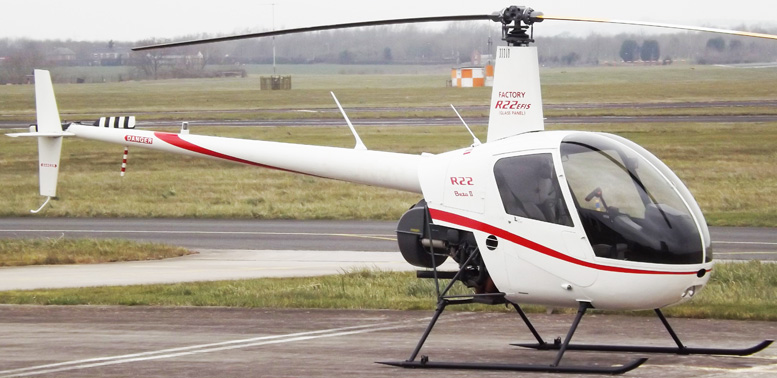
I practiced a few pickups and set-downs while waiting for traffic and after a few minutes of isolation, I “assumed the position” and blasted off. The R-22 accelerated quickly through 60 knots and pattern altitude was reached quickly.
I enjoyed five trips around the pattern and was amazed to discover how much the scenery improved when I got to fly all by myself. After the fifth and final trip around the pattern, I hovered in and set the R-22 down somewhat gently.
I felt really good about what I had accomplished. This group had trained me very well. I had lived through the whole thing! (Despite my best efforts.) The ensuing hours were spent sharpening my new skills and racking up the five hours of solo time that were part of the 30 hour course. Before long, I was almost ready for the checkride.
There was only a night checkout and some full touchdown autorotations to complete before I got to try for my Commercial ticket. These skills were going to be learned in the presence of Larry Durocher and I was a bit nervous about flying with a 5000 hour military helicopter veteran who would also eventually be giving me my checkride.
Larry Durocher and NHI have been operating the R-22 since 1980 and were one of the first schools in the country to have one. If anyone would have his act together, it would be this fellow. The night checkout was nervy at first since the super visibility afforded by this machine didn’t do me a whole lot of good at night (other than to scare the hell out of me).
The lack of all this outside reference had me a bit freaked but Larry solved this by immediately switching off the landing light and making me work harder to find my references. Before long, this extra work allowed me to relax and get used to flying at night.
The night checkout was intensive, we did straight in and 180 degree autorotations as well as a few run on landings in the darkness. By the time that he got out, I was really ready for night flight.
A half hour of solo time later, I reluctantly hovered onto the ramp and shut the R-22 down. The night flying was much more fun than I’d expected. Quite a change from the way I had started that lesson!
My last official lesson turned out to be the full touchdowns with Larry that I had been anxiously anticipating. Flying to a nearby airport, Larry cranked the throttle all the way off and started into an unpowered descent at 60 to 65 kts.
He cautioned me that there was very little wind that day and that a run-on landing would probably be necessary since the energy that a cyclic flare could dissipate could do only so much before the collective came up and the ground did likewise.
The touchdown seemed like child’s play in the hands of a fellow like Larry since our first was quite a bit softer than many of the powered landings that I had made thus far.
The whole procedure seemed to be a matter of quick timing and proper planning. The few tries that I made were not nearly as good but I nonetheless survived to tell the tale. By the end of February, I was ready for the check ride.
My log showed exactly 25 hours of instruction received and five hours of solo flight. 30 hours . . . I guess I was ready. Paul’s pre-checkride advice was endearing. “Don’t make me look like a fool,” he smiled. Believe me, I was gonna do my best not to.
Larry smiled and told me to relax, that we were going to have some fun and see what I had learned (it was not what I knew that worried me . . .). After the initial paperwork, we got right to the oral which was heavily weighted with questions about “rotordynamics” and the R-22.
Thirty minutes of this verbal barrage was followed with a decision that I had done well enough with the Oral to justify a flight check. My pre-flight was thorough and seemed to take forever—though I managed to finish just as Larry stepped out to take a seat next to yours truly (such a trusting soul!).
We started with all the normal operations and a few hops around the patch with nary a hint of the traditional Examiner’s malevolent mayhem. I was ready for him to chop the power at any second, I knew that he would sooner or later, it was only a matter of time. . . .
He chopped the power. Cranking around into a 180 degree autorotation, I came in a little on the hot side but did my best to dissipate that energy by easing back slightly on the cyclic which caused my airspeed to go to blazes a lot faster than I expected.
Oh well, the first try was passable and the subsequent ones were a bit better — at least I wouldn’t have killed anybody. Run-on landings, quick stops, max performance takeoffs and approaches to a confined area filled the rest of the ride before Larry motioned me back to the ramp (while no doubt thanking the good Lord that he was still alive).
As the rotor spun to a halt, he told me to meet him inside without giving me a clue as to whether I had passed or failed. Buttoning up the R-22 for the night took forever as the suspense began to eat me alive.
I was sure that I had passed; though my autos could have used a little work and the one confined area approach had been a little hot. . . . I’m sure you all know how I was feeling. I tried to act nonchalant as I walked into Larry’s office to see if he was typing up a dreaded pink failure slip or a white temporary license.
I couldn’t see any white or pink as I scanned the office desperately searching for clues to the fate of my check ride (flunking would have meant tuna fish sandwiches for at least a month).
Larry came up behind me and handed me a white slip of paper awaiting my signature. “Looking for this?” he inquired. Hah! I had passed. T’was a heady moment. I was a helicopter pilot . . . or so I thought.
In the few years that have passed since then, I have logged several hundred hours as a commercial helicopter pilot and obtained a helicopter flight instructor rating. An engine failure a year later (not in an R-22) went real well and I began to think of myself as a real live chopper pilot from that time on only.
There’s always a bit of doubt until the dreaded moment comes, but the success is sweet when you pass the test and keep your buns attached to the rest of your anatomy.
Helicopter flying is challenging, demanding and immensely rewarding. The value of good training though, is especially critical in this field—helicopters can be awfully unforgiving of careless operation.
Though the commercial value of such a rating is immense (hiring is on the rise); the sport value is incredible since the helicopter can go so many places that an airplane can’t. The degree of freedom afforded to the chopper jockey is incredible.
To those with an interest in helicopters; I have to recommend the pursuit of a rating—it isn’t nearly as expensive as it used to be and not a whole lot more than some of the fixed wing rates that I’ve seen lately. Just be sure to get a hold of a good training school.
The ultimate safety device is your brain and loading it with the proper information is the best way to keep yourself in the best of health so that you can enjoy these critters as much as the rest of us rotorheads.
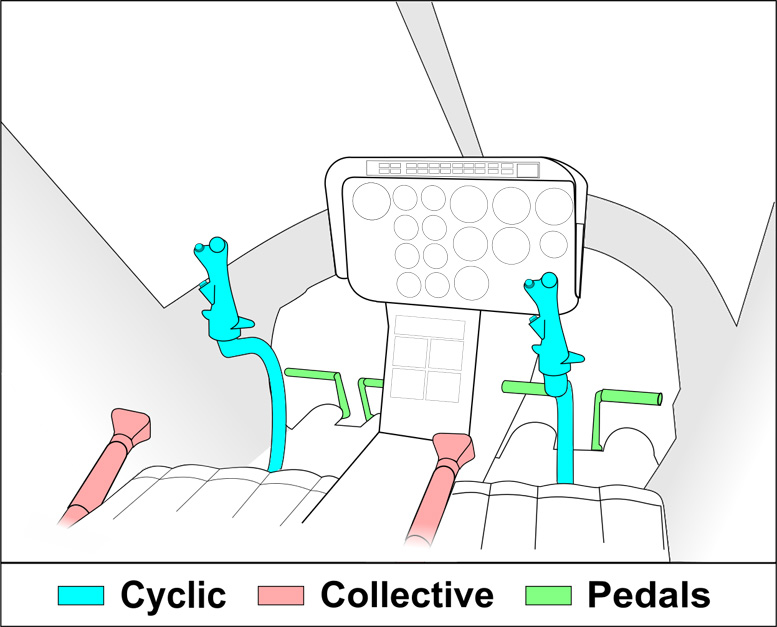
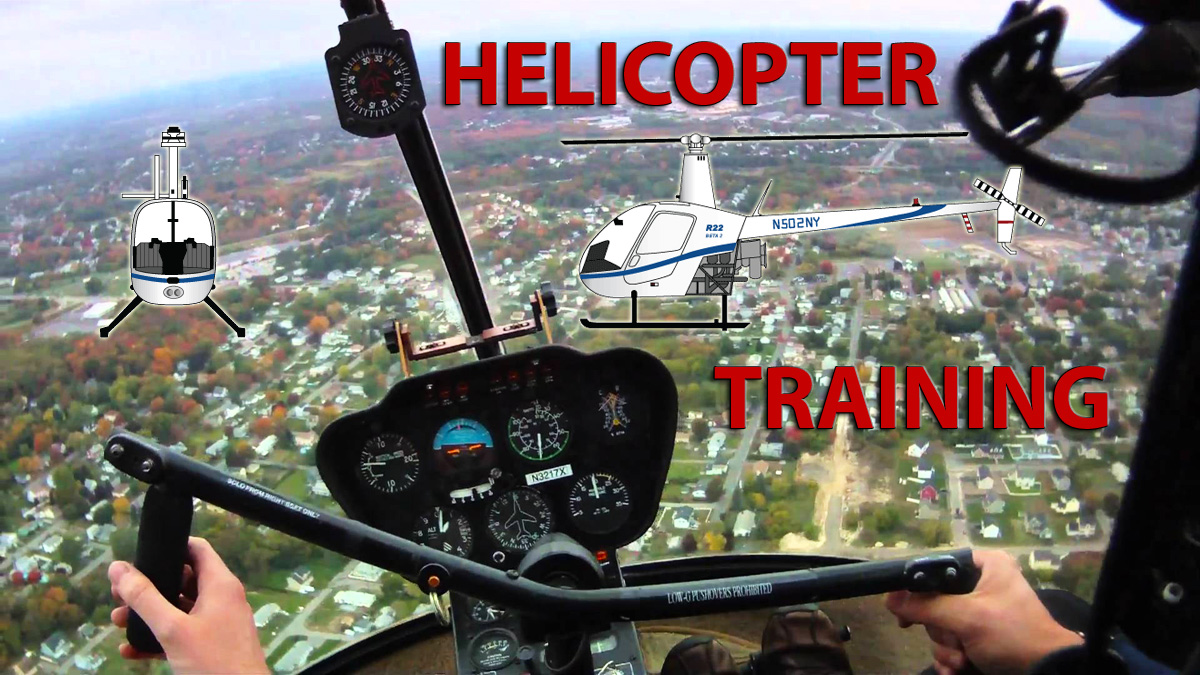

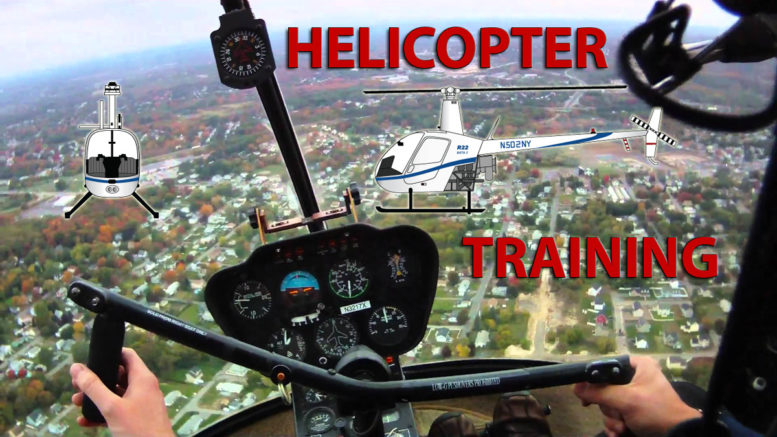
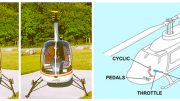
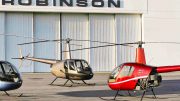
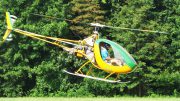
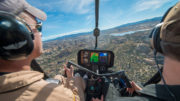
Be the first to comment on "R22 Pilot – Beating the Air Into Submission"